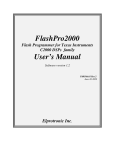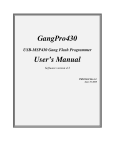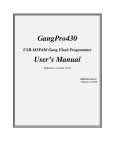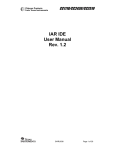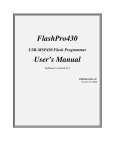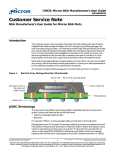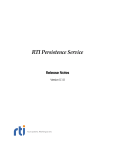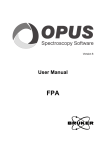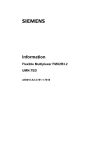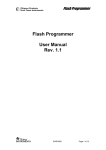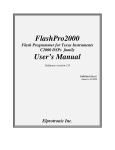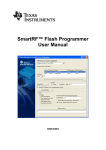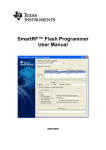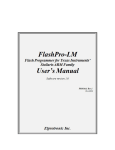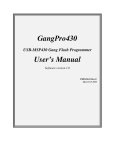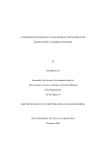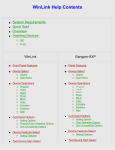Download Gang-Pro CC and Production Programming of
Transcript
Application Note AAN056 AN056 GangPro-CC and Production Programming of the CC2430 SWRA157 By Gregory Czajkowski - Elprotronic Inc. Keywords • • • • • “CC2430" “Flash Programmer” “GangPro-CC” “ZigBee” “Serialization” 1. Introduction The CC2430 is the first single chip IEEE 802.15.4 compliant and ZigBee TM SoC (System on Chip) RF Transceiver with integrated 8051 microcontroller and memory flash. Method of the flash programming in production is discussed in this application note. This application note describes flash programming of the CC2430 using the GangProCC programmer from Elprotronic. A single GangPro-CC programmer can simultaneously program and automatically assign an IEEE address for up to six target devices. When more then six target devices should be programmed simultaneously, then more GangPro-CC programmers can be used and controlled via the Multi-FPA API-DLL. Up to eight programmers can be controlled from external software written in MS Visual C++, Borland C++, MS Visual Basic, LabVIEW etc. which allow simultaneous programming of up to 48 target devices. Effectively, this method allows for programming of whole PCB panel before depanelization and speeds-up the programming process. A target device can be used by any board with CCxx SoC that has access to the SoC 2-wire debug interface (Debug Clock (DC), Debug Data (DD) and Reset line). In this application note the CC2430 ZigBee Development Kit as a target device (Battery Board SOC_BB 1.1 and CC2430EM 1.2) has been used as an example. This development kit is described in detail in TI’s application note SWRU073B “CC2430ZDK and CC2431ZDK ZigBee Development Kit Pro”. The GangPro-CC is described in Elprotronic’s manuals PM025A01 “GangPro-CC Programmer User’s Guide” and PM025A02 “GangPro-CC API-DLL User’s Guide” available on http://www.elprotronic.com/download.html SWRA157 AN056 GangPro-CC and Production Programming of the CC2430 (Rev. 1.0) 2007-09-24 Page 1 of 21 Application Note AAN056 The GangPro-CC programmer package consists of a microcontroller based adapter (Figure 1-1), WindowsTM based software, a Gang Splitter to connect up to 6 devices Figure 1-1 to the adapter, and a cable to connect the adapter with the computer’s USB port. The internal firmware software allows for communication with the programmed device at a high speed. The effective programming speed (write only) is around 20 kbytes/s simultaneously for up to six target devices which is equivalent to 120 kbytes/s programming speed per one programmed target device. For example, six devices with 128 kB Flash, such as CC2430F128, can be programmed in 12 seconds. This time includes initialization, erasing memory, blank checking, programming and fast verification. To simplify the production process the programming software package can assign IEEE address, serial number, model type, and revision. Each IEEE address and serial number are unique for each programmed device and are assigned automatically. Several serial number formats are available. There are a number of erase/write options available as well. This allows to erase/write all flash memory, or just the specified fragment of memory. This feature is very useful when only part of programmed data/code should be replaced. For example one can download the serial number, calibration data or personality data without erasing existing program code. SWRA157 AN056 GangPro-CC and Production Programming of the CC2430 (Rev. 1.0) 2007-09-24 Page 2 of 21 Application Note AAN056 2. Hardware connection TI’s development board (Figure 2-1) uses a 10 pin connector (Figure 2-2) for communication with the CCxx devices, which allows to program target device via “SoC debug” interface (via connector P5 - SoC debug/flash on the SOC_BB board). Figure 2-1 Table 2.1 Target’s Device connector Pin # Name Description 1 GND Ground 2 Vdd / Sense Vdd used to set correct voltage for the voltage level connector and can be used to supply target device. 3 DC Debug Clock 4 DD Debug Data 5 do not use do not use 6 do not use do not use 7 RST RESET - Active LOW 8 do not use do not use 9 Vdd / alt NC Deliver Vdd from external source (OPTIONAL) Header - Top View Figure 2-2 From all available pins only 5 pins (pin numbers 1,2,3,4,7 - respectively GND, Vdd, DC, DD, RST) should be used for communication with the MCU via SoC debug interface (Table 2.1) . All other pins are used for other applications. SWRA157 AN056 GangPro-CC and Production Programming of the CC2430 (Rev. 1.0) 2007-09-24 Page 3 of 21 Application Note AAN056 The GangPro-CC Flash Programmers (Figure 2-3) use the 14-pin connector to facilitate connections with six target devices. Connector layout and pin descriptions are shown on Figure 2-4 and Table 2.2. When the GangPro-CC programming adapter is connected to target devices then all clock signals (DC) should be connected in parallel to target devices and all six bidirectional data lines (DD) should be connected to each target device. Remaining lines (RST, Vdd, GND) are connected to all target devices in parallel (Figure 2-5). Figure 2-3 Header - Top View Figure 2-4 SWRA157 AN056 GangPro-CC and Production Programming of the CC2430 (Rev. 1.0) 2007-09-24 Page 4 of 21 Application Note AAN056 Table 2.2 GangPro-CC Interface connector Pin # Name Description 1 (Red) DD-1 Debug Data output / Input - 1 2 Vdd / Sense Vdd supplied to the target ( 2.2 to 3.6V/ max 100 mA) and the target’s Vdd voltage sense. This pis should be connected to target’s device Vdd if device is supplied from the Flash Programming Adapter. If the target’s device is supplied from his own battery or from external power supply then the pin 2 or 4 (Vdd sense) should be connected to device’s Vdd. 3 Busy BUSY - 1 when the communication with target is active. 4 Sense Target’s Device Vdd Sense (see pin-2 description) 5 do not use do not use 6 DD-2 Debug Data output / Input - 2. 7 DC Debug Clock - common clock to all target devices 8 Vdd-En Used to control external power supply. Voltage 2 to 5V -> Power Supply ON 9 GND Ground 10 DD-3 Debug Data output / Input - 3. 11 \RST Reset output Figure 2-5 SWRA157 AN056 GangPro-CC and Production Programming of the CC2430 (Rev. 1.0) 2007-09-24 Page 5 of 21 Application Note AAN056 To simplify connections between programming adapter and six target devices the GangPro-CC splitter can be used (Figure 2-6). Gang Splitter contains one 14-pin Figure 2-6 connector that should be connected to programming adapter, and six 10-pin connectors that should be connected to six target devices. Pinout of the six 10-pin connectors is the same as the pinout in TI’s development boards. Figure 2-7 (block diagram) and Figure 2-8 show connection that allows to program up to 48 target devices from one PC using eight GangPro-CC programmers with Gang Splitters and D-Link USB-HUB. Figure 2-7 SWRA157 AN056 GangPro-CC and Production Programming of the CC2430 (Rev. 1.0) 2007-09-24 Page 6 of 21 Application Note AAN056 Figure 2-8 When a lot of target devices are programmed simultaneously in production, it is not convenient to connect all cables from programming adapters to each target device separately. It is recommended to prepare test bench with nails, that allows to connect all boards from the panel (before depanelization) to GangPro-CC directly or via GangPro Splitters (Figure 2-8). Target device boards should be specially designed for it and should contain test points that can be connected via nails to programmer. When all boards are programmed (and eventually partially tested) then all boards can be depanelized. Figure 2-9 SWRA157 AN056 GangPro-CC and Production Programming of the CC2430 (Rev. 1.0) 2007-09-24 Page 7 of 21 Application Note AAN056 During the programming process target devices can be supplied directly from programming adapters or from external power supply. When target devices are supplied from programming adapters then voltage level can be programmable from 2.2V to 3.6V with step of 0.2V. Current load up to 100 mA (this means - up to 16 mA per target device if up to six target devices are connected to one programming adapter). If this current is not sufficient, then external power supply should be used to supply target devices. GangPro-CC allows to control ON/OFF (enable/disable) and external power supply. Figure 2-10 show connection of the target devices supplied from programming adapter or from external power supply. If an external power supply is used, then it is recommended to connect pull-down load (eg. resistor 10k) between power’s supply enable input and ground. Pin 2 (Vdd/Sense) of the programming adapter must be connected to Vdd of target devices, even if the external power supply is used. The Vdd level from the target devices is used to supply the voltage level translator, that allows to convert logic levels from/to programming adapter’s microcontroller from 3.3V to/from levels required by the target devices (2.2V to 3.6V). Figure 2-10 SWRA157 AN056 GangPro-CC and Production Programming of the CC2430 (Rev. 1.0) 2007-09-24 Page 8 of 21 Application Note AAN056 3. Software GangPro-CC programmer package contains two types of software that allow to program target devices via USB-FPA programming adapter. First - application software contains graphic user interface (GUI). This software allows to control one programming adapter (USB-FPA) connected up to six target devices to this adapter. Software allows to erase, blank check, program and verify memory flash in target device. Full or part of the flash memory can be erased, programmed and verified. The IEEE address and serialization can be automatically generated and saved in the flash memory. Available script file option allows to create custom defined programming sequence. See Elprotronic’s manual PM025A01 “GangPro-CC Programmer User’s Guide” for details. Second - the Multi-FPA API DLL allows to simultaneously control up to eight programming adapters (USB-FPA). Up to six target devices can be connected to each programming adapter. In total - up 48 target devices can be programmed simultaneously using Multi-FPA API-DLL. When the Multi-FPA API-DLL is used then the application software which uses this DLL should be written by the user. Application software can be written in Visual C++, Visual Basic, LabVIEW etc. The IEEE address and serialization should be generated by application software if these numbers are required. List of available instructions are specified and described in the Elprotronic’s manual PM025A02 “GangPro-CC API-DLL User’s Guide”. 3.1 Application software with GUI To start the GangPro-CC programmer click on the GangPro-CC Elprotronic icon (Figure 3-1). Once started the software will attempt to access the programming adapter. If no error messages appear then the software has initialized without a problem and you may begin using it. However, if the programming adapter is not detected an error message will appear. To correct the problem, make sure that the connection cable is properly attached and the USB driver is installed. Figure 3-1 SWRA157 AN056 GangPro-CC and Production Programming of the CC2430 (Rev. 1.0) 2007-09-24 Page 9 of 21 Application Note AAN056 The programming dialogue box (Figure 3-2.) contains a pull down menu, interface selection box, lock protection bits box, device action buttons, report (status) window, open file buttons, target device information box, IEEE addresses and serial number box, power DC status and check sum result boxes. At the beginning, desired target device type should be selected. In our example when the TI’s CC2430ZDK boards are used, in the SoC Device Type group it should be selected device - CC2430F128 (Flash size 128 kB). When the target devices are supplied power from programming adapter, then in the Power Device from Adapter group desired voltage and Enable box should be selected. Using Open Code File button requested code file should be opened. Three code formats are accepted - TI hex (*txt), Intel hex (*.hex) and Motorola s (*.s19, *.s28 or *.s37). In the Target Devices Programming Result group the Target Enable should be selected. A minimum of one target device should be enabled. If more then one target device are connected to programmer, then all target devices must be the same type. Size of the desired flash memory to be erased and programmed can be defined in the Memory Option dialogue screen (Figure 3-3) accessible from pull down menu - Setup->Memory Option. Typically All Memory option should be selected. In the Retain Flash Data group a part of flash memory can be selected, of which the contents will be restored after erase and programming. This option is useful if flash contains calibrated data and data should not be erased after Figure 3-2 programming process. Retain data block sizes can be up to 2048 bytes and can be located at any place - in one or more flash sectors. When the programmed contents are modified only in part of flash memory, then the Used Defined option can specify SWRA157 AN056 GangPro-CC and Production Programming of the CC2430 (Rev. 1.0) 2007-09-24 Page 10 of 21 Application Note AAN056 four flash blocks that can be erased and programmed. It should be noted, that if any part of flash segment is specified in the defined block, then full segment will be erased (typical flash segment size is 2 kB for flash size 128 kB), however only specified flash address range will be programmed and verified. In the field Flash Lock Bits after Autoprogram the desired option that allows to protect selected part of flash memory (selected flash memory, boot sector or access to debug option) when flash is programed should be selected. Selected flash segments cannot be modified by application program when they are protected. User should know if their application program has access to modify flash memory, otherwise application program cannot work if access to write protected flash is required. If the lock bits are programmed in target devices and access to target device is blocked, it is possible to get access to target device again, but only if full flash memory will be erased. It is not possible to retain any data if debug bit is locked. To automatically unlock and erase full memory contents if lock bits are programmed in the target device, the Unlock debug option should be selected in the Memory Erase/Program and Verify group (Figure 3-3). Figure 3-3 When desired configuration is selected then in the Main Dialogue screen (Figure 3-2) the Lock Protection Bits option can be used to enable or disable programming of selected lock bits. SWRA157 AN056 GangPro-CC and Production Programming of the CC2430 (Rev. 1.0) 2007-09-24 Page 11 of 21 Application Note AAN056 When Autoprogram is pressed, then selected target devices should be erased, programmed and verified. Following information should be displayed in the Report window (Figure 3-4). If serialization and IEEE address are not selected, then the lines related to these items will not be displayed. Figure 3-4 In the Target Device Programming Result (Figure 3-5) should be displayed all OK icons if all targets are programmed and verified successfully. If programming process in one target failed (eg. erase failed) then process in all other targets is continued as long as minimum one target is programmed without errors. At the end one programmer target without errors will have green (OK) icon, while others - red (ERROR) icons in location where the errors has been detected. Figure 3-5 3.1.1 IEEE Address and Serialization The GangPro-CC programming software has the ability to automatically create the target device’s IEEE Address and Serial Number and save it in flash memory. These numbers are also saved in the database file. The new IEEE Address and Serial Number can be created automatically by incrementing the IEEE Address and Serial Number or can be taken from a file created by the user. Furthermore, model name, group, and revision can be downloaded to target device. The IEEE Address format contains 8 bytes located at the end of the flash memory or specified location of the SWRA157 AN056 GangPro-CC and Production Programming of the CC2430 (Rev. 1.0) 2007-09-24 Page 12 of 21 Application Note AAN056 flash memory and can be saved in order - LSB or MSB byte first. The Serial Number format and location in the device’s flash memory must be specify by the user. IEEE Address and Serial Number are created when the Auto Program or Write SN /Write IEEE Addr button is pressed and the Serialization feature is enabled. When the Auto Program function is activated then the IEEE Address and/or Serial Number are programmed to the target device’s memory along with the code data. If the Auto Program function fails for any reason then new IEEE Address / Serial Number is not created. The software also allows the device to retain its IEEE Address / Serial Number if one has already been assigned to it. Every time a device is programmed and serialization is enabled the contents of the target’s memory are scanned for existing IEEE Address and Serial Number. If numbers are found in the database, the dialogue screen will appear and allow you to decide if you wish to keep the old IEEE Address / Serial Number, new or manually entered once. See User’s Guide for details. The IEEE Address setup and Serialization setup are accessible from pulldown menu IEEE/Serialization Setup. When the IEEE Address and Serialization Setup is selected then following dialogue screen is displayed (Figure 3-6). The IEEE address can be created automatically by incrementing the IEEE address from specified value (see Figure 3-6), or can be taken sequentially from user defined file containing list of required IEEE Addresses. All assigned IEEE addresses are Figure 3-6 SWRA157 AN056 GangPro-CC and Production Programming of the CC2430 (Rev. 1.0) 2007-09-24 Page 13 of 21 Application Note AAN056 saved in database file specified in the SN/IEEE Record File line. When the assigned IEEE address has also been found in the database, then warning will be displayed. The GangPro-CC software allows to generate unique serial numbers that can be saved in any flash location. Serialization format and location in flash memory should be specified by user (see Figure 3-6). All serialization options are described in detail in the User’s Guide. It should be noticed that Serial Number and IEEE address should be saved in location where the application program is empty. Not any data (even 0xFF) can be specified in the code data in the location where the serial number, model or IEEE Address should be saved. Otherwise warning will be created and verification can fail. Verification procedure will find data in FLASH location other than data (even 0xFF) specified in the code data at location where the serial number, model or IEEE address has been written. 3.1.2 Configuration setup Programming software can save configuration settings. This allows the user to create several configuration files, one for each particular task, and thus eliminate the need to manually change settings every time a different configuration is desired. Furthermore, the config.ini file contains the most recently used settings and those settings will be used as default whenever the software is started. To create a configuration file simply select Save Setup from the File menu. Current settings will be saved for future use. To restore configuration settings select Load Setup from File menu and select a file containing the settings you wish to restore. In order to prevent accidental setup changes the GangPro-CC Programmer provides the option to Lock configuration settings. When the user selects the Lock/Unlock Setup option from the Setup menu, the Programmer will prevent the user from modifying the setup. The only options that are available when the programmer is locked are Verify, Read, Autoprogram and Next. Notice that the Next button will immediately change to implement the Autoprogram function. To unlock the programmer the user must select the Lock/Unlock Setup option from the Setup menu. Configuration setup file (or Code file) can be opened using Load Setup (Load Code) option from File menu or can also be opened using command line combined with the executable file name. Following command line switches are available -sf Setup_file_name ( Download setup file ) -cf Code_file_name ( Download Code file ) -nf IEEE/SN_ file_name (Download IEEE addresses / Serial number list file ) -rf Script_file_name ( Run programming sequence from the Script File ) -lock (Lock almost all buttons. Prevent the user from modifying the setup) Using Windows START button (left bottom) select Run.. Using Browse.. find and select executable file SWRA157 AN056 GangPro-CC and Production Programming of the CC2430 (Rev. 1.0) 2007-09-24 Page 14 of 21 Application Note AAN056 “C:\Program Files\Elprotronic\CCxx\USB GangPro-CC\GangPro-CC.exe" and at the end enter the required key with name of the setup file and extra key “-lock” can be added if required, eg. “C:\Program Files\Elprotronic\CCxx\USB GangPro-CC\GangPro-CC.exe” -lock -sf C:\MFG\prg-04.cfg On Figure 3-7 the Main GUI dialogue screen is presented with locked buttons when the “-lock” option is used. Only few buttons are active that can run programmer, but all buttons/pull down menu that can modify programmer’s setup are blocked. Instead writing above command every time when the programmed is activated, it is possible to create icons with parameters listed above and use selected icon from the desktop to activate programmer with required switches. See User’s Guide for details. 3.1.3 User defined programming sequence - Scrip File Figure 3-7 Programming sequence can be customized using script file. Script file prepared as a text file (using any editor like notepad) can contain customized programming sequences in any order. Generally, all buttons available on the main dialogue screen can be used in the script file. All other options available on others screens like memory options, serialization type etc. cannot be modified from the script file directly, but can be reloaded in fully using configuration file. From the script file any configuration files can be called at any time that allows to modify programmer configuration. This method can simplify programming process using script file and SWRA157 AN056 GangPro-CC and Production Programming of the CC2430 (Rev. 1.0) 2007-09-24 Page 15 of 21 Application Note AAN056 allows to use full options available in the programmer. Programming sequence conditions can be taken from user defined procedures attached as an independent DLL. Function should be created using Visual C++ and attached to GangPro-CC software. See Elprotronic’s manuals PM025A01 “GangPro-CC Programmer User’s Guide” for details. LIMITATIONS: 1. Up to 1000 script lines commands can be used. Empty lines and lines with comments only are ignored and not counted. 2. Up to 50 CALL’s deep stack is used (CALL in CALL in CALL......). SYNTAX: white spaces before instructions, labels etc are ignored. ; comment - all contents after semicolon are ignored. NOTE: Comment cannot be used in the lines where the file name is specified. >label - character ‘>’ without spaces must be placed before label name. NOTE: After label ca not be specified any command in the same line. Line can contain label only. LIST OF INSTRUCTIONS: MESSAGEBOX type FCTEXT - pop-up message box with buttons. - message taken from the FCONTROL function (User’s DLL) MESSAGEBOX type - pop-up message box with buttons. “ message - line -1 “ - Text displayed in message box. “ message - line -2 “ - Each line contents must be located between characters “ ” “ max up to 50 lines “ - Number of content lines - up to 50 lines. Message box type list OK OKCANCEL YESNO YESNOCANCEL - One button OK - Two buttons OK , CANCEL - Two buttons YES , NO - Three buttons YES , NO, CANCEL GOTO label CALL label RETURN - CALL procedure. - return from CALL. IF condition GOTO label IF condition CALL label condition list: BUTTONOK BUTTONYES BUTTONNO BUTTONCANCEL DONE FAILED CONTROL = number - if button OK pressed in the message box. - if button YES pressed in the message box. - if button NO pressed in the message box. - if button CANCEL pressed in the message box. - if selected process e.g. AUTOPROGRAM finished successfully. - if selected process e.g. AUTOPROGRAM failed. - if status from the FCONTROL function = NUMBER FCONTROL type argument - call the external function from FxControl DLL SWRA157 AN056 GangPro-CC and Production Programming of the CC2430 (Rev. 1.0) 2007-09-24 Page 16 of 21 Application Note AAN056 PAUSE number - pause in miliseconds - 1 to 100000 range (1ms to 100 s). OPENDLLFILE filename - FxControl DLL file - Full path and DLL File name. LOADCFGFILE filename - Configuration file - Full path and File name. LOADCODEFILE filename - Code file - Full path and File name. LOADSNFILE filename - IEEE/SN file - Full path and File name. VCCOFF - Turn OFF Vcc from programming adapter to target device. VCCON - Turn ON Vcc from programming adapter to target device. Note: Vcc from FPA must be enabled first using configuration file. RESET -equivalent to pressed button RESET on the main dialogue screen. AUTOPROGRAM -equivalent to pressed button AUTOPROGRAM on the main dialogue screen. VERIFYACCESS -equivalent to pressed button VERIFY LOCK BIT on the main dialogue screen. ERASEFLASH -equivalent to pressed button ERASE FLASH on the main dialogue screen. BLANKCHECK -equivalent to pressed button BLANK CHECK on the main dialogue screen. WRITEFLASH -equivalent to pressed button WRITE FLASH on the main dialogue screen. VERIFYFLASH -equivalent to pressed button VERIFY FLASH on the main dialogue screen. READFLASH -equivalent to pressed button READ/COPY on the main dialogue screen. READSN -equivalent to pressed button READ SN on the main dialogue screen. READIEEE -equivalent to pressed button READ IEEE Addr on the main dialogue screen. LOCKFLASH -equivalent to pressed button LOCKFLASH on the main dialogue screen. TRACEOFF - trace OFF. TRACEON - trace ON and saved in the “Trace-Scr.txt” file in current working directory. Option useful for debugging. Trace file contains sequence of all executed commands from script file in the run time. On the left side of all lines the current line numbers correspondent to the line number in the script file are printed. Line numbers are counted without empty lines and without lines contains comments only. END - end of script program. Below are the contents of an easy script file that allows to create following sequence; 1. Vcc supplied to target device is turn-OFF and first message box with buttons OK/CANCEL is displayed. Programmer is waiting until button OK or CANCEL is pressed. 2. When confirmed, then first configuration file test-A.cfg is downloaded to programmer. Configuration file test-A.cfg should be prepared first using programming software with desired configuration, selected desired code file etc. Programmer’s configuration should be saved using “Save setup us ..” option. 3. When test code is downloaded and processor started (if enabled in test-A.cfg file) then message box is displayed and software is waiting until button YES / NO is press. Meantime manual target’s device test can be done. If test is positive, then button OK should be pressed, or button NO if test failed. 4. When button OK has been pressed then programmer downloads finalcode.cfg configuration file to programmer. Current configuration can activate serialization if required, reload final code to be downloaded etc. When the new configuration is reloaded then final code is downloaded to target device, serialization is created etc. 5. On the end, programmer returns to beginning and waits for the next target device to be connected. SWRA157 AN056 GangPro-CC and Production Programming of the CC2430 (Rev. 1.0) 2007-09-24 Page 17 of 21 Application Note AAN056 ;===================================================== ; Script file - demo program ;---------------------------------------------------->START VCCOFF MESSAGEBOX OKCANCEL "VCC if OFF now. Connect the test board." "When ready press the button:" " " "OK - to test the board" "CANCEL - to exit from program" IF BUTTONCANCEL GOTO finish LOADCFGFILE C:\Elprotronic\Project\Cpp\GangPro-CC\test-A.cfg MESSAGEBOX OK "Press OK to download the test program." AUTOPROGRAM MESSAGEBOX YESNO "Press YES when the test finished successfully." "Press NO when the test failed." IF BUTTONNO GOTO START LOADCFGFILE C:\Elprotronic\Project\Cpp\GangPro-CC\finalcode.cfg AUTOPROGRAM GOTO START >finish END ;======================================================= When the executable file GangPro-CC.exe is called with a script path as an argument e.g. GangPro-CC.exe -rf C:\Program Files\test\script.txt or when the icon with the GangPro-CC.exe and script file path is executed then programmer starts automatically programming sequences according to procedure specified in the script file. 3.2 Multi-FPA API-DLL GangPro-CC Flash Programmer can be remotely controlled from other software applications (Visual C++, Visual Basic etc.) via a DLL library. The Multi-FPA allows to remotely control up to eight Flash Programming Adapters (FPAs) simultaneously significantly reducing programming production time. Figures 2-7 and 2-8 show the connections between PC and up to eight programming adapters. The FPAs can be connected to PC USB ports directly or via USB-HUB. Direct connection to the PC is faster but if the PC does not have required number of USB ports, then USB-HUB can be used. The USB-HUB should be fast, otherwise speed degradation can be noticed. When the USB hub is used, then the D-Link’s Model No: DUB-H7, P/N BDUBH7..A2 USB 2.0 HUB is recommended. SWRA157 AN056 GangPro-CC and Production Programming of the CC2430 (Rev. 1.0) 2007-09-24 Page 18 of 21 Application Note AAN056 Block diagram of the Multi-FPA application DLL is presented on Figure 3-8. To support the Multi-FPA API-DLL feature, the software package contains following dll files - the Multi-FPA API-DLL selector - up to eight standard single FPAs API-DLLs Figure 3-8 The Multi-FPA API-DLL selector allows to transfer functions coming from application software to desired single application API-DLL (GangProCC-FPA1.dll to GangProCC-FPA8.dll) or to all API-DLL simultaneously. It should be noticed that all single API-DLLs (GangProCC-FPA1.dll to GangProCCFPA8.dll) are fully independent from each other. From that point of view it is not required that transferred data to one FPA should be the same as the transferred data to the others FPAs. For example, code data downloaded to FPA-1 can be different than the code data downloaded to FPA-2, FPA-3 etc. The F_AutoProgram can be executed simultaneously with selected all active FPAs. All FPAs will be serviced simultaneously by their own API-DLL and data packages saved in these dlls. Also programmers allow to save unique data to each target devices even if these targets are connected to the same programming adapter (each programming adapter can service up to six target devices). This allows to program unique serial numbers or IEEE addresses, unique calibration data etc. to each target devices separately. This process can be done simultaneously to all targets, even if saved data to each targets are not the same. SWRA157 AN056 GangPro-CC and Production Programming of the CC2430 (Rev. 1.0) 2007-09-24 Page 19 of 21 Application Note AAN056 Software package provided by Elprotronic Inc. contains all required Multi-FPA APIDLL files, as well as demo programs with source code written under Visual C++. Demo programs software can be modified by user for custom requirements. One of the presented demo program allows to simultaneously control up to eight gang programming adapters that allows to program up to 48 target devices. Source code and all related project files are located in the following directory: C:\Program Files\Elprotronic\CCxx\USB GangPro-CC\API-DLL-Demo\Cpp\Demo-8x6 Program can be activated by selecting the GangProCC-8x6-Demo.exe in the \release subdirectory, or can be activated from the windows menu: Start->Program->Elprotronic-Flash Programmer->(CCxx) USB GangPro-CC->API-DLL-8x6-Demo-Cpp When the program is executed, then following GUI dialogue screen is displayed (see Figure 3-9). See the Elprotronic’s manual PM025A02 “GangPro-CC API-DLL User’s Guide” available on http://www.elprotronic.com/download.html for detailed descriptions of all available instructions in the Multi-FPA API-DLL and description of the demo programs included in the GangPro-CC software package. Figure 3-9 SWRA157 AN056 GangPro-CC and Production Programming of the CC2430 (Rev. 1.0) 2007-09-24 Page 20 of 21 Application Note AAN056 References 1. “CC2430ZDK and CC2431ZDK ZigBee Development Kit Pro” - TI’s application note SWRU073B 2. “GangPro-CC Flash Gang Programmer for the CC series devices User’s Manual” - Elprotronic’s GangPro-CC User’s Guide PM025A01 3. “GangPro-CC Flash Programmer for the CC series devices - Chipcon product from TI. Remote Control Programming User’s Guide” Elprotronic’s GangPro-CC API-DLL User’s Guide - PM025A02 Document History Revision Date 1.0 2007-09-24 Description/Changes Initial release. SWRA157 AN056 GangPro-CC and Production Programming of the CC2430 (Rev. 1.0) 2007-09-24 Page 21 of 21 IMPORTANT NOTICE Texas Instruments Incorporated and its subsidiaries (TI) reserve the right to make corrections, modifications, enhancements, improvements, and other changes to its products and services at any time and to discontinue any product or service without notice. Customers should obtain the latest relevant information before placing orders and should verify that such information is current and complete. All products are sold subject to TI’s terms and conditions of sale supplied at the time of order acknowledgment. TI warrants performance of its hardware products to the specifications applicable at the time of sale in accordance with TI’s standard warranty. Testing and other quality control techniques are used to the extent TI deems necessary to support this warranty. Except where mandated by government requirements, testing of all parameters of each product is not necessarily performed. TI assumes no liability for applications assistance or customer product design. Customers are responsible for their products and applications using TI components. To minimize the risks associated with customer products and applications, customers should provide adequate design and operating safeguards. TI does not warrant or represent that any license, either express or implied, is granted under any TI patent right, copyright, mask work right, or other TI intellectual property right relating to any combination, machine, or process in which TI products or services are used. Information published by TI regarding third-party products or services does not constitute a license from TI to use such products or services or a warranty or endorsement thereof. Use of such information may require a license from a third party under the patents or other intellectual property of the third party, or a license from TI under the patents or other intellectual property of TI. Reproduction of TI information in TI data books or data sheets is permissible only if reproduction is without alteration and is accompanied by all associated warranties, conditions, limitations, and notices. Reproduction of this information with alteration is an unfair and deceptive business practice. TI is not responsible or liable for such altered documentation. Information of third parties may be subject to additional restrictions. Resale of TI products or services with statements different from or beyond the parameters stated by TI for that product or service voids all express and any implied warranties for the associated TI product or service and is an unfair and deceptive business practice. TI is not responsible or liable for any such statements. TI products are not authorized for use in safety-critical applications (such as life support) where a failure of the TI product would reasonably be expected to cause severe personal injury or death, unless officers of the parties have executed an agreement specifically governing such use. Buyers represent that they have all necessary expertise in the safety and regulatory ramifications of their applications, and acknowledge and agree that they are solely responsible for all legal, regulatory and safety-related requirements concerning their products and any use of TI products in such safety-critical applications, notwithstanding any applications-related information or support that may be provided by TI. Further, Buyers must fully indemnify TI and its representatives against any damages arising out of the use of TI products in such safety-critical applications. TI products are neither designed nor intended for use in military/aerospace applications or environments unless the TI products are specifically designated by TI as military-grade or "enhanced plastic." Only products designated by TI as military-grade meet military specifications. Buyers acknowledge and agree that any such use of TI products which TI has not designated as military-grade is solely at the Buyer's risk, and that they are solely responsible for compliance with all legal and regulatory requirements in connection with such use. TI products are neither designed nor intended for use in automotive applications or environments unless the specific TI products are designated by TI as compliant with ISO/TS 16949 requirements. Buyers acknowledge and agree that, if they use any non-designated products in automotive applications, TI will not be responsible for any failure to meet such requirements. Following are URLs where you can obtain information on other Texas Instruments products and application solutions: Products Applications Amplifiers amplifier.ti.com Audio www.ti.com/audio Data Converters dataconverter.ti.com Automotive www.ti.com/automotive DSP dsp.ti.com Broadband www.ti.com/broadband Interface interface.ti.com Digital Control www.ti.com/digitalcontrol Logic logic.ti.com Military www.ti.com/military Power Mgmt power.ti.com Optical Networking www.ti.com/opticalnetwork Microcontrollers microcontroller.ti.com Security www.ti.com/security RFID www.ti-rfid.com Telephony www.ti.com/telephony Low Power Wireless www.ti.com/lpw Video & Imaging www.ti.com/video Wireless www.ti.com/wireless Mailing Address: Texas Instruments, Post Office Box 655303, Dallas, Texas 75265 Copyright © 2007, Texas Instruments Incorporated






















